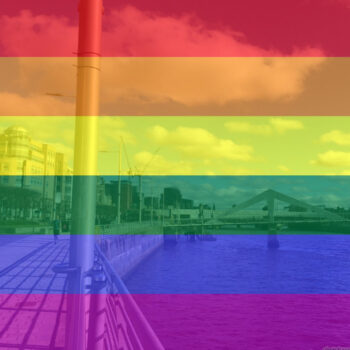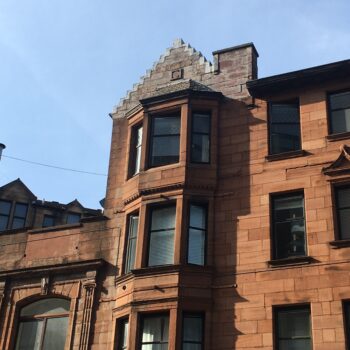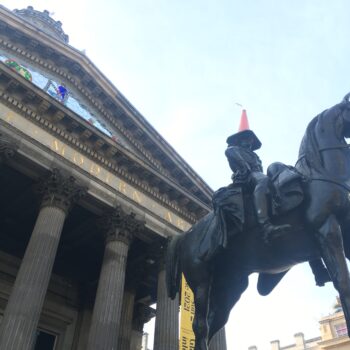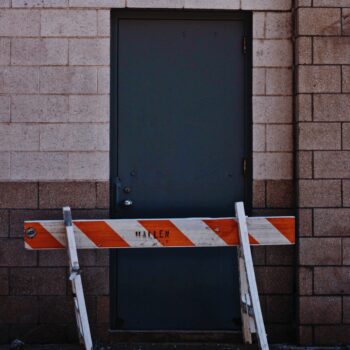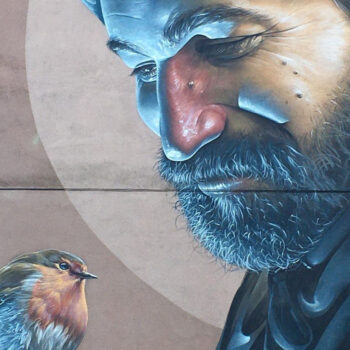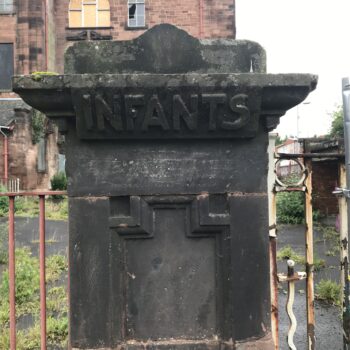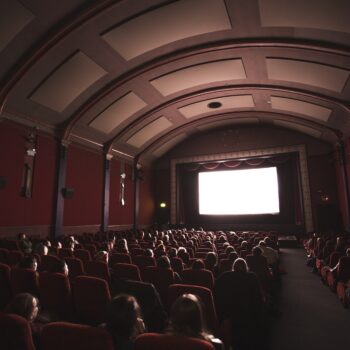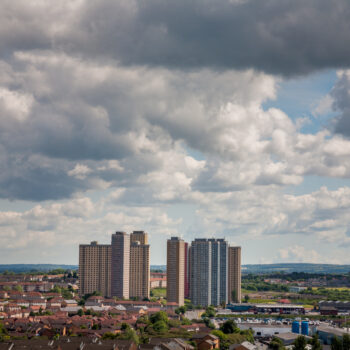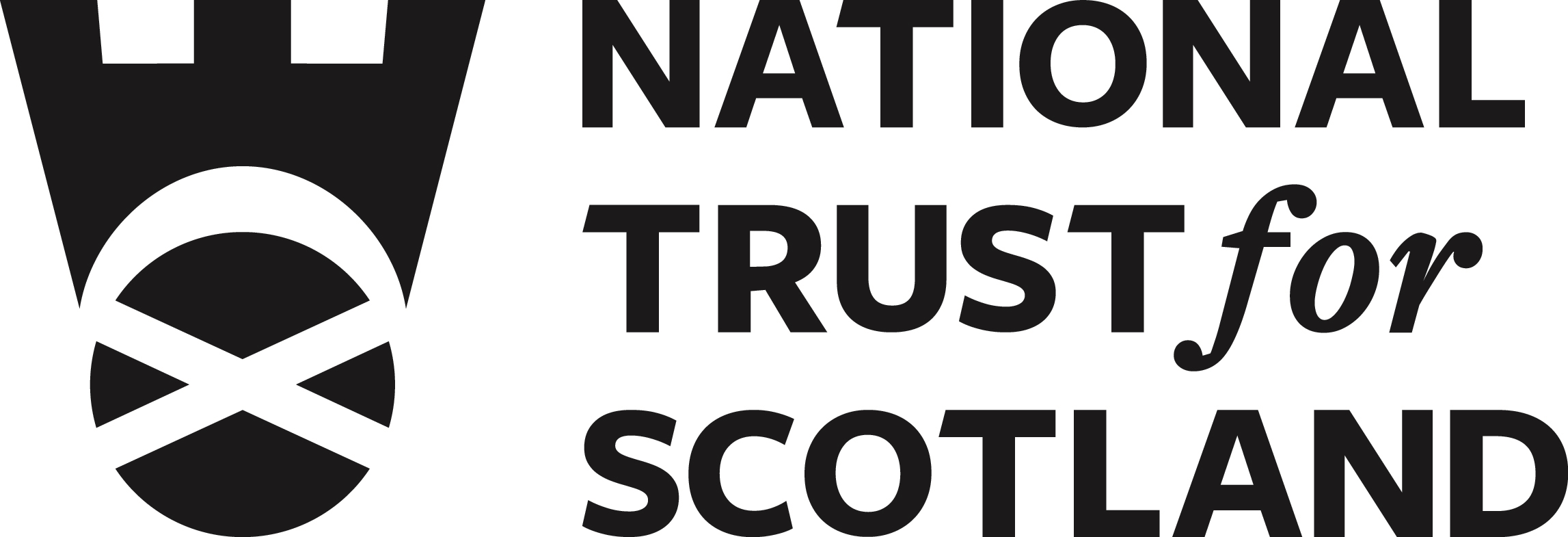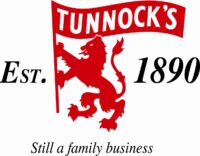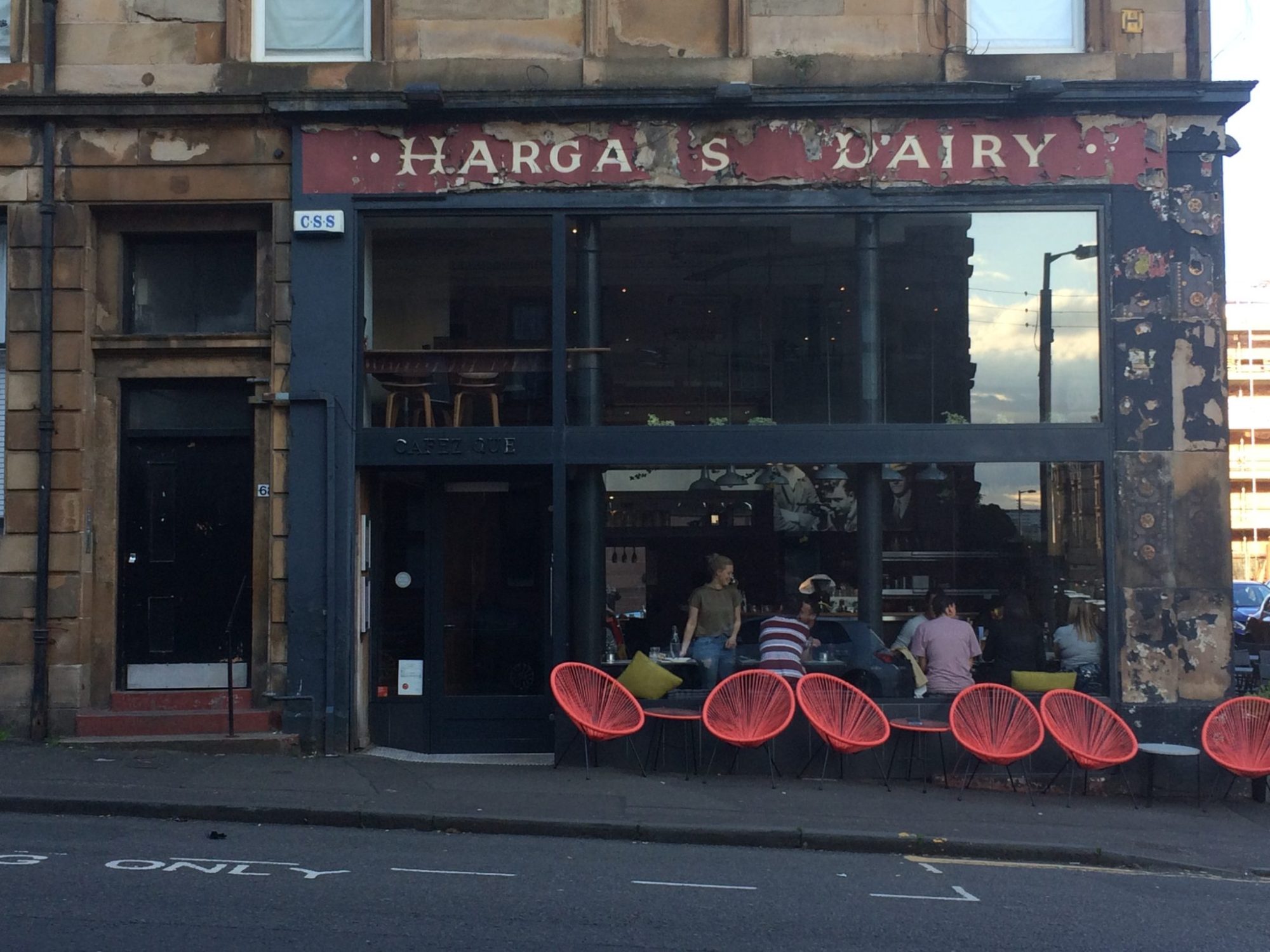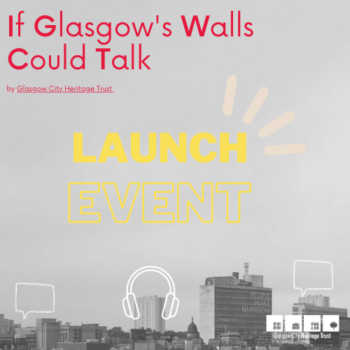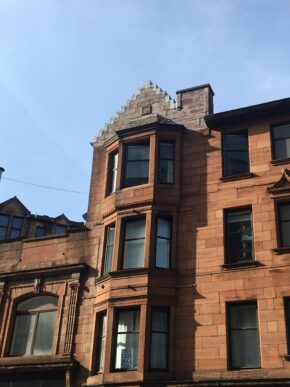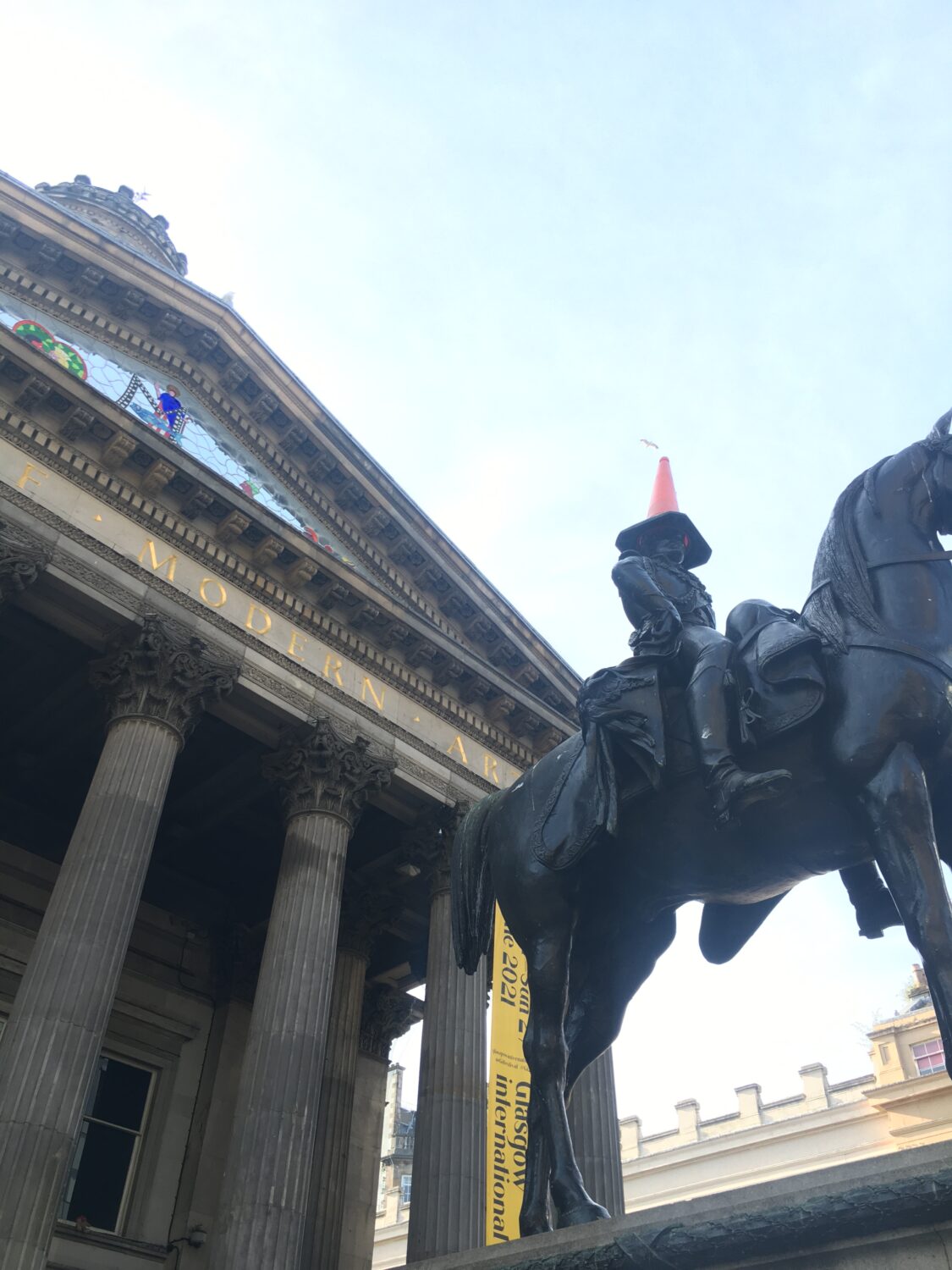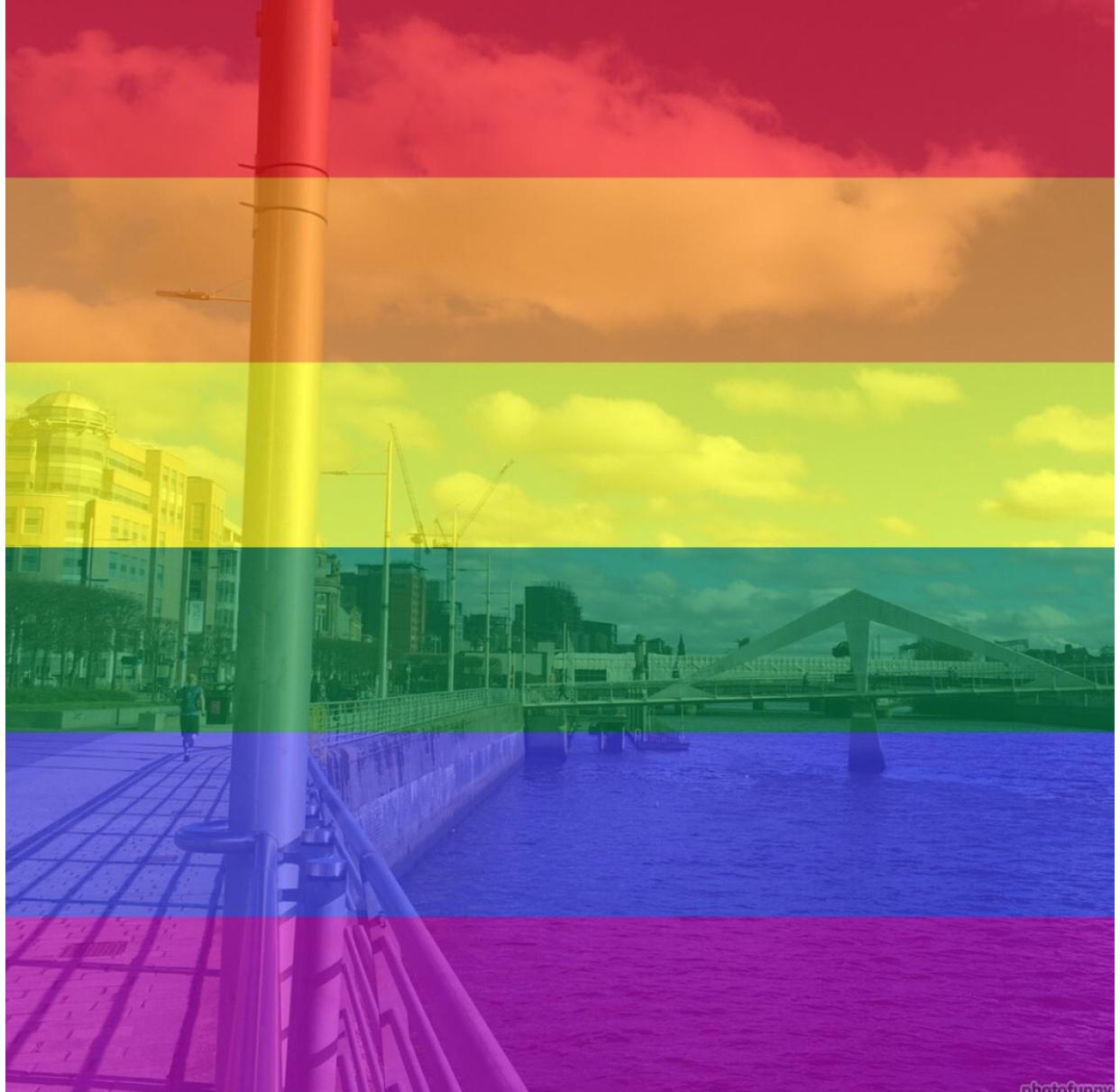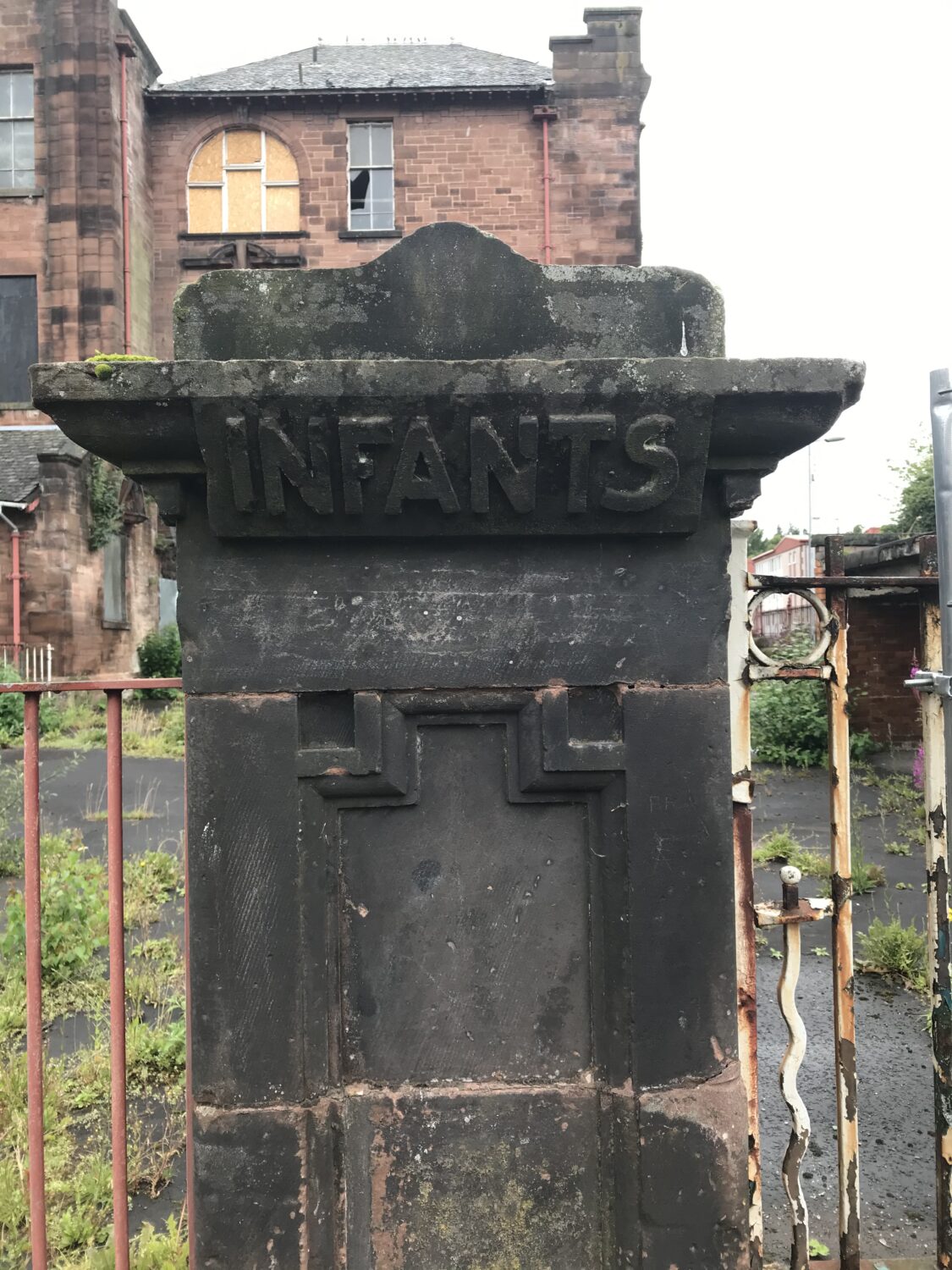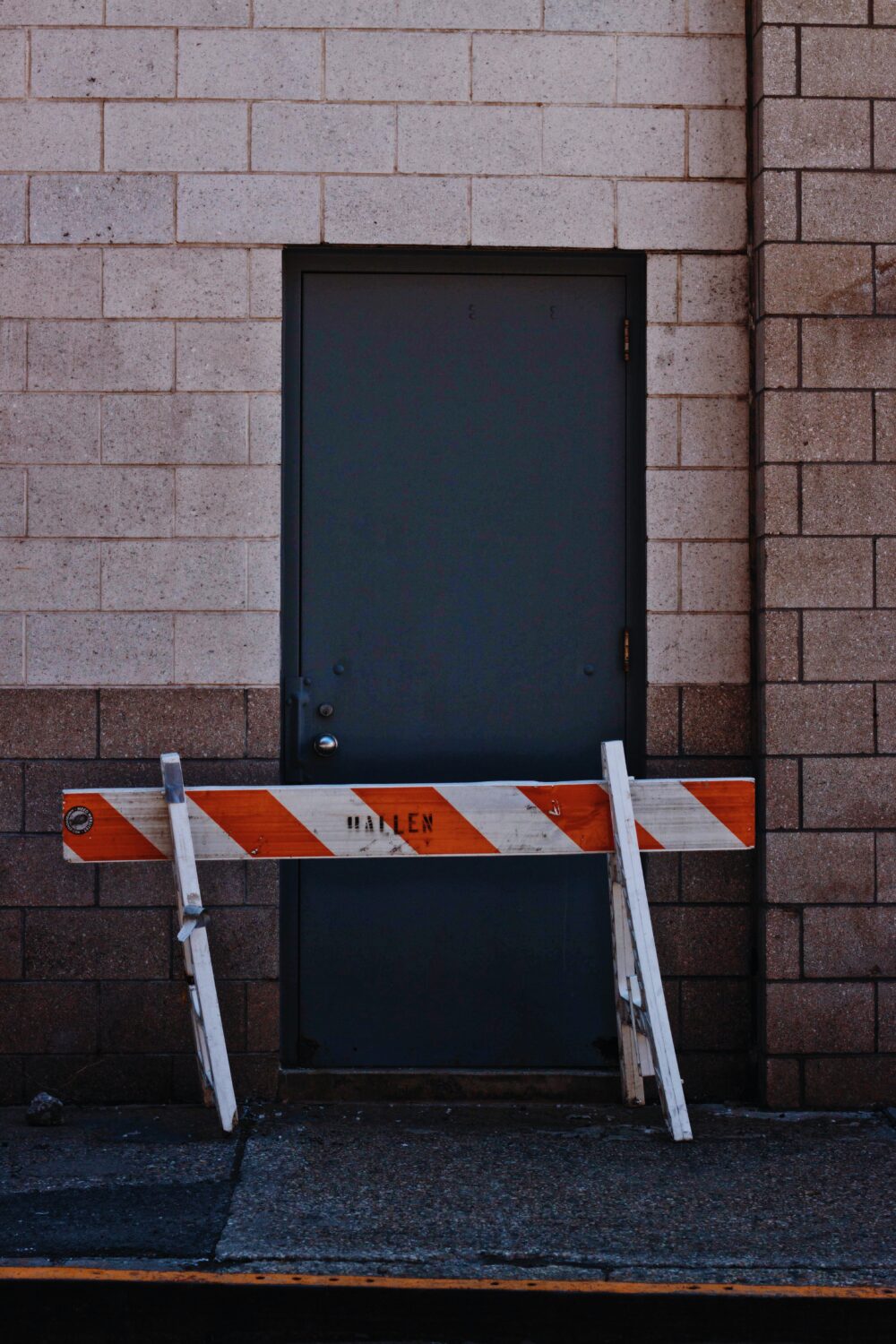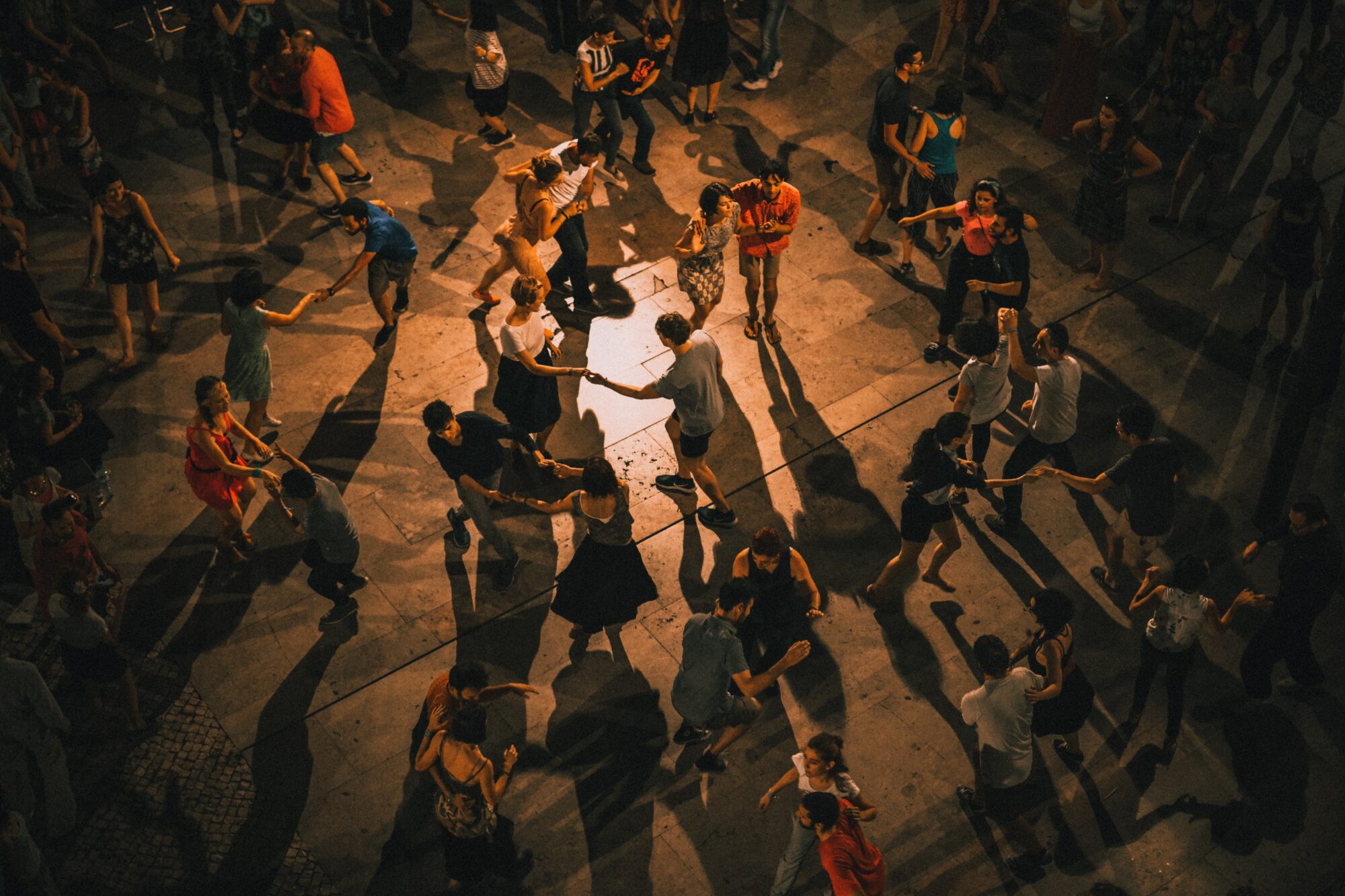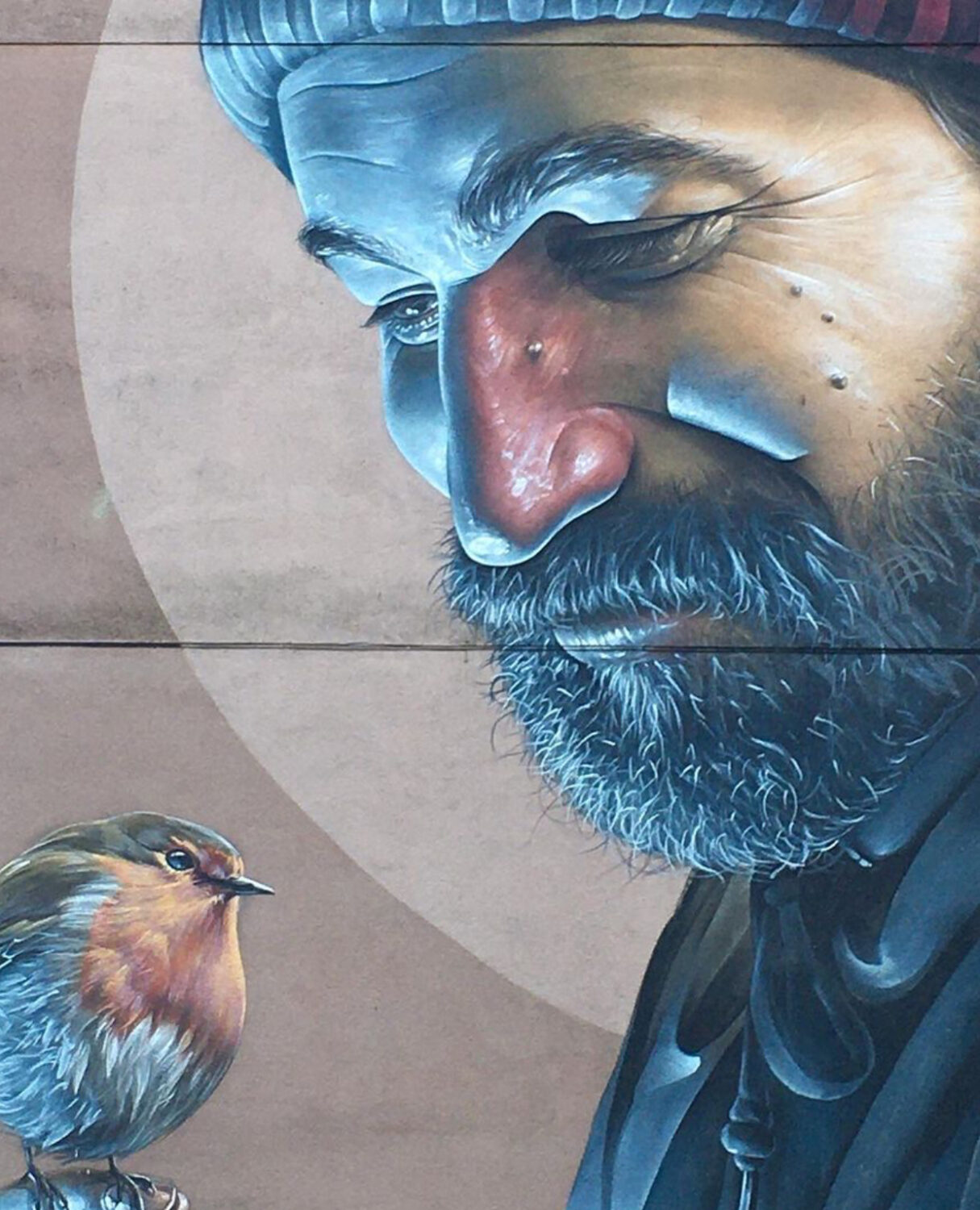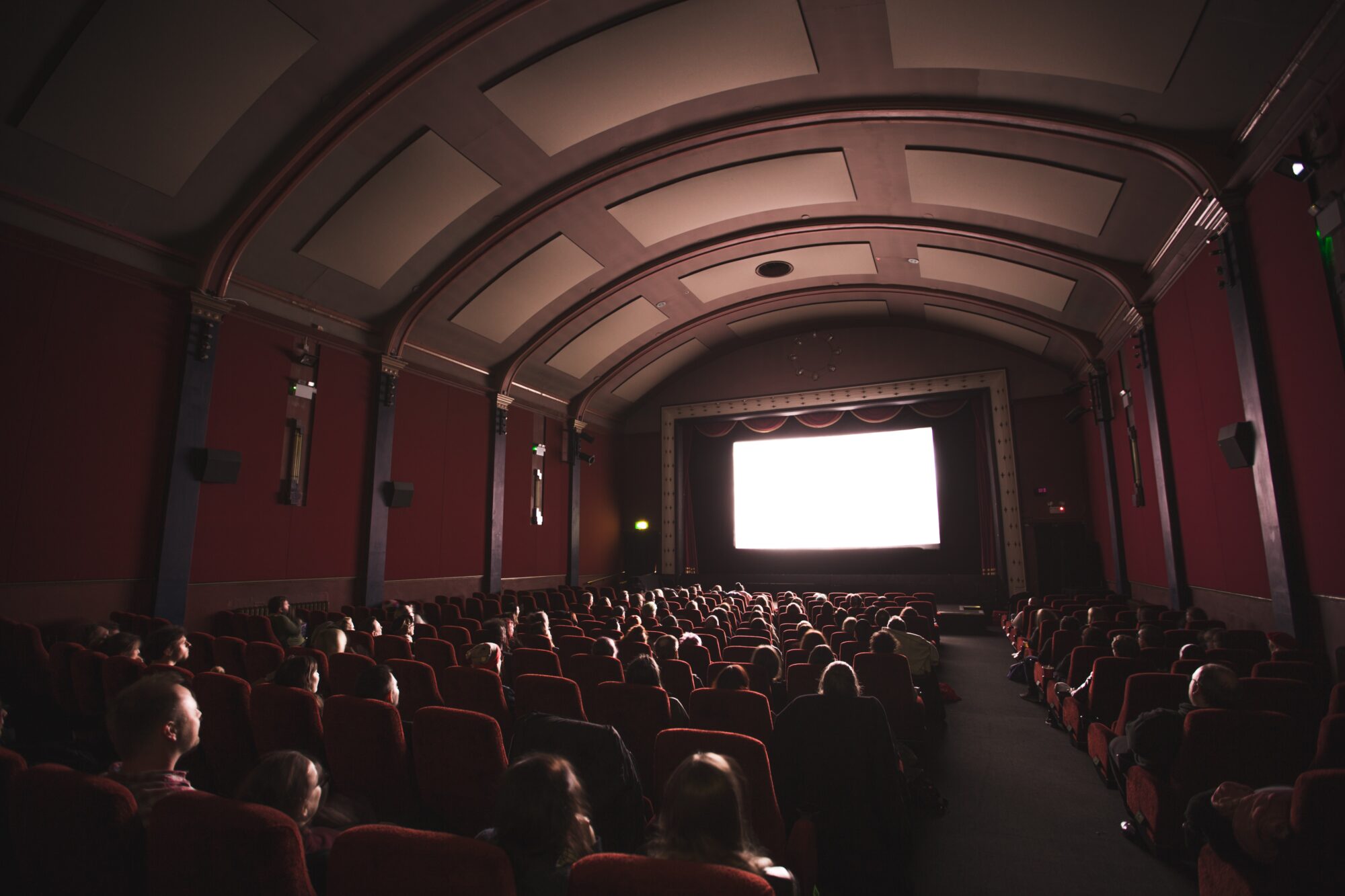Hello, and welcome to Glasgow City Heritage Trust podcast, “If Glasgow’s Walls Could Talk”, a new series about the relationships, stories and shared memories that exist between Glasgow historic buildings and people.
Niall Murphy
Hello, everyone, I’m Niall Murphy and welcome to If Glasgow’s Walls Could Talk, a podcast by Glasgow City Heritage Trust about the stories and relationships between historic buildings and people in Glasgow.
In this episode, we’ll be talking about historic school buildings, why there are so many and how the community can get involved in their preservation. If you’re listening from Glasgow, I’m sure you have a historic school building in your neighbourhood and possibly more than one.
Have you ever wondered why they are so many old schools in our city? Well, the high number of historic school buildings in Glasgow has to do with the Education Scotland Act of 1872. This law made Elementary Education compulsory and free for all the children in Scotland between 5 and 13.
The Scotland Education Act took inspiration from the Elementary and Education Act that passed in England and Wales in 1870. Although this act is considered the foundation of the Scottish modern school system, unfortunately, it played a big part in the repression of the Scottish Gaelic language. The effect of this reform has been described as disastrous and contributed to destroying Gaelic communities and culture.
However, before 1872, 40% of Scottish children, so that’s around 35,000 children of compulsory school age, did not attend school. So under the new Education Act, approximately 1000 large purpose built schools were created to accommodate new students. Poverty was not accepted as an excuse to avoid attending classes and help was provided through the Poor Laws. in Glasgow 75 new schools were built between 1873 and 1918. Each school accommodating between 800 to 1000 pupils, the cost and the upkeep and preservation of these massive Victorian and Edwardian school board buildings has been a constant challenge for the council, the pupils and communities.
Some of these buildings, such as the handsome B listed St. Denis primary school, built in 1883 by James Salmon & Son, or the internationally renowned A listed Scotland Street School Museum, designed by Charles Rennie Mackintosh and soon to be a school once more, are still in use and enjoyed by their communities as places to learn.
Sadly, some of these historic school buildings have met a quite different future, one characterised by uncertainty and dereliction among these unlucky buildings, we can find in Pollokshaws, The Sir John Maxwell School designed by John Hamilton in 1906, or the B listed Haghill Primary School. Unfortunately, both these handsome schools have fallen into serious disrepair since they closed for good.
So what can the community do to save these buildings? Are they salvageable or even worth saving?
In Glasgow one of the best known examples of a community taking ownership of historic building and saving it from certain demolition is Govanhill Baths. One of the pioneers in community ownership in Glasgow, and I must declare an interest here is I am also the chair of Govanhill Bath Building Preservation Trust who are working on the repairs just now.
So the Campaign to save Govanhill Bath began in January 2001, when Glasgow City Council informed the community and users that it was to close the bath on 31st of March that year without any local consultation. In response, community members occupied the school from 17th of March to 7th of August that year, so at 140 days, it remains the longest occupation of a public building in British history. Govanhill Bath is now a thriving grassroots activist based organisation delivering a wide range of health, well being, arts, environmental and heritage projects. Another great example of a community taking ownership and repurposing historic building, in this case a school, and it’s the focus of this episode is Kinning Park Complex on Cornwall Street, which overlooks Plantation Park.
Kinning Park Complex is an independent multi use community space in the south side of Glasgow. Providing a variety of great activities in a place that brings people together, helps reduce isolation, builds friendships, and creates a real sense of community. The complex is well used by local organisations, dance and sports groups, artists, musicians and community projects.
Kinning Park complex is located in an old red sandstone building, built in 1916 as an annex to the Lambhill Street Primary School. In 1976. The building was converted into the Kinning Park neighbourhood centre run by the council. However, local residents and supporters had to fight to keep their much loved Community Centre open when in 1996 was threatened with closure due to council cuts for 55 days and nights the group stayed in the centre 24 hours a day. That determination and passion are the reason why Kinning Park Complex exists today as an independently run organisation where the community can flourish.
Their vision is for the Kinning Park complex to be owned by the community, providing facilities and services developed and governed by the community for its community. So today, our guest is Martin Avila, director of Kinning Park Complex. Originally with a background in non formal education and intercultural learning, Martin became involved in social enterprise early in his career, leading him to become director of the Kinning Park Complex, where he became more involved in community ownership and community led regeneration. Martin is currently a board member of SURF, Scotland’s regeneration forum, and treasure a community land Scotland a membership body for community landowners in Scotland, and the voice of Scotland’s land reform movement. So welcome to the podcast, Martin.
Martin Avila
Hi, Niall.
Niall Murphy
It’s good to have you here Martin. So we’ve got some questions for you. And the first one is, what was the original motivation for saving Kinning Park neighbourhood centre back in the 1990s?
Martin Avila
You know, it’s a really good question as well now. And I think most likely, it’s probably going to have been a confluence of a whole range of different motivations, because everybody brings their own, you know, ideas to the table, I think one of the strongest kind of collective motivations, would have been the need to keep the services running that ran out of the Kinning Park Complex.
I think there was a lot of after school services and services for local children. And they were really key in providing the support for working parents, you know, especially working women to be able to continue to bring in an income for the families, I think that was part of the motivation, and also, one of the main drivers within that occupation. And certainly, within the early years of the Kinning Park Complex, was a lady called Helen Kyle. And she had kind of own motivations behind it as well, she really wanted to show that small self governing entities could play a role in wider society. And I think she had a bee in her bonnet around the representation of Scotland on the European stage. And she wanted to show that just because something was small, and not necessarily part of something bigger, it didn’t mean that it wasn’t viable. And so that was her kind of own personal motivation, but I think a lot of the motivations or folks were around keeping the services going, that we’re running from the Kinning Park Complex. Right?
Niall Murphy
Okay. So other people who started the process, are they still involved?
Martin Avila
No, not at all. Actually, I mean, that process was over 20 years ago. And they, I would say that’s probably been maybe, you know, three generations realistically since then. And we’re probably just about to embark on a fourth generation where maybe some, you know, some transition periods in between so Helen was really key as part of the sit in, and alongside a whole range of other people who play the leading role. And and she was involved in running the Centre for the first 10-13 years of its existence.
And then Helen moved on, and a chap called Lindsay Keenan came in, he had spent some time as the head of campaigns for the Nordic Region for Greenpeace, and wanted to come back and do something about more grassroots after having been involved in and starting a national campaign, such as don’t drill in the Arctic, which was eventually successful and secure a moratorium for drilling.
And then there was really myself coming out alongside a lady called Rachel, who became the operations manager. And that was that at least for the folks that were in the leadership positions, the folks that have been in the committees have changed over the years. And then those folks who’ve played driving forces, you know, even if they don’t can have any official position within the organisation. And I think that is really one of the main challenges also, actually, as a community organisation, which is responsible for, you know, a piece of built heritage, because that’s going to go on, you know, hopefully built heritage should have much longer lifespan than anybody’s one role within an organisation. So trying to deal with the transitions between, you know, generations, let’s see it as I’ve tried to bring folks in and give them space to have their own ideas and their own ability to shape the future, whilst maintaining a link to the heritage of the past, as you know, as one of the challenges.
Niall Murphy
Absolutely. So is it still very much embedded in the community in the sense that your volunteers and the people on the board, they’re all people who are based in the local community,
Martin Avila
It is now, but it has not necessarily been the case? I think there’s there’s been a kind of transaction alongside also the kind of use of the building. And so when the, you know, and also there are certain things that we don’t necessarily have historical records and I’ll probably talk about that a little bit later on. When you ask when the questions that I think you may ask about favourite buildings, but in the end, The, I think that, you know, the building really deteriorated over a bit of time. And so, you know, at one point, actually, before Lindsay came, and after Helen moved on, the building really wasn’t in a fit state, I don’t, you know, it came close to being closed again, because of the state, you know, they were able to secure money for the windows, but because of the issues around the lease, and, you know, if we talk about community asset transfer later on, it’s something that I can come back to, but because of the issues that around the lease, it wasn’t necessarily something that we could secure capital funding for.
Niall Murphy
No, no, I totally understand that. Yeah, that’s a major, major issue that.
Martin Avila
Yeah, and so for a long time, the building wasn’t really in a state that people could really use, you know, until it became less and less and less usable. And so as that happened, I think less and less, you know, services that appeal to local people were running from it and it started to become mainly used as a kind of underground venue, you know, for fringe arts and fringe politics, and a little bit more left field. Those kinds of initiatives are more drawn toward ungoverned spaces, and a certain extent, that’s what kept it going.
So, you know, when Rachel and I came in July 2015, essentially, we thought that our first job was going to be securing a 25 year lease secure a million pounds for the building renovation. And actually, you know, that changed for a couple different reasons. As I said, I’ll come back to later on. But also one of the first things that we realised is that building wasn’t really serving local people anymore. You know, there were some dance classes, but the majority of folks didn’t know what happened in the building, the majority of folks that were involved and running the building went from the local area. Well, that’s something that’s changed now, where the majority of board members live within five minutes walk, the majority of members being drawn from the local area as well. And also, as we are starting to get some energy in terms of not diverting all our energy and making a building, which is really difficult to maintain, you know, stay operational, we are then left to wonder on the day to day basis and thinking about what else has happened in the neighbourhood. And we’re getting a good bit of traction with something called the Local Place Plan, which is something which is something that came in after the planning act.
Niall Murphy
Yes. Some something I’d like to touch on on later on. Yeah, it’s interesting, because I can see a lot of parallels with what’s happened at Govanhill Baths. So I mean, for instance, and this, this happens with other organisations too, who are, you know, working out in historic building, which needs maintenance, those budgets, obviously, getting the money to do that is not straightforward, particularly, according to your lease situation.
And so that was one reason why the Govanhill Baths Community Trust, who are the actual people who do all the stuff with Govanhill Baths, everybody knows about set up the Building Preservation Trust to deal with the kind of the capital repairs to the building, because it meant that there was a group that could focus on that alone. And it didn’t detract from what the mission of the organisation actually was. So and I think, I think that’s quite important. But yeah, definitely recognise where you’re coming from. So for instance, before we ended up having to vacate the building, which we did about 18 months before we actually started work on the building itself. And that was just because it got to the point where it was so cold and damp, because didn’t have a heating system. And what for what the Community Trust had done was they basically built themselves a wee hut inside the building that was a proper insulated hut, because you’ve got, you know, these huge bases where the pools are, which are really, you know, they were open to the elements, essentially, with broken windows, etc. So they went into that wee hut to keep warm during the day. So it’s not exactly an ideal situation, when you’re trying to, you know, carry out your everyday jobs and responsibilities. So some people do have to think about.
Martin Avila
It is about making it an inviting space for the rest of the community to come. And we will do exactly the same except our hut was built in. And you know, when I became a bit of a joke in the winter time you know, waiting to go, It’s like a cabin trip in the summer in Scotland, when you’re trying to figure out how long you can get away with going without going for a pee. And, you know, it kind of turning to your comrades and say like, listen, folks, it maybe take some time, you know, not really sure if you’re gonna make it back because from the trip for the toilet.
Martin Avila
Yeah, absolutely. I totally understand how you feel about that. Okay, so how do you keep staff and volunteers motivated and enthusiastic about Kinning Park Complex’s vision and mission? How do you go about doing that?
Martin Avila
You know, I think it probably requires a few different things. It requires some really special people to be involved in the first place. You know, so the the staff and the volunteers that were involved in the Kinning Park Complex, had a lot of motivation for the sort of things that we were wanting to do and requires a lot of energy from from a leadership team, who really, you know, you really have to have somebody coming on board, at least during those times of, you know, essentially crisis, who who’s gonna live and breathe the building and take real responsibility for that.
It’s also maybe why governance structures has to change as you move out of those kind of places, because having more command and control structure, let’s say, or, you know, more streamlined governance works well, within those those, you know, those, those times of difficulty, where there’s actually in the long term, we want a much more distributed leadership model.
I think also, right, it’s, it’s about the stories of what the building does. So if I think what really motivated the staff to deal with the challenges that we had as because some of the things that happened, and the Kinning Park Complex, you know, I can’t I imagine that this is a as true, but in different flavours, in other community owned buildings, some of the things that happened in the Kinning Park Complex just wouldn’t have happened and other spaces, you know, apart from maybe somewhere like Govanhill Baths actually be fair, because that can heady mix of locals that have lived there for a long time, new Scots who have not long, you know, made their life in the city, and, you know, folks who are, you know, intrinsically interested in creative projects, which involve community and folks that are interested in arts and folks that are interested in community development, you know, that kind of heady mix of things, that we had a kind understanding that you’re, all you can realistically do within the world is probably two things right? Make a decent impact on one individual. And we know for a fact that there are individual stories there, that the Kinning Park Complex has really helped people, you know, whether it has had a big impact on their life.
So a certain extent in that micro level was changing the world, and also create what I would describe as these little bubbles of beauty, you know, like these little bubbles of magic, these transitory moments, they exist in one event and one interaction, and one project and one programme and one weekend. And after that they go, but realistically, think about actually, in the grand scheme of the universe, that’s probably the highest thing you can ever really do. So I think it’s, you know, it’s given them space, it’s getting the right people, it’s given them energy, and it’s doing fantastic things that then give you the energy and the drive to deal with all the challenges.
Niall Murphy
Absolutely, I really do recognise that from from Govanhill Baths as well. And it’s something that really inspires me about the community trust there, and how effectively they’ve tried to work to do that, within this community. And I think, you know, in many ways, you can see how that’s been very central to the regeneration of Govanhill as an area and has kind of made it desirable for artists and people like that to move into. So I absolutely recognise where you’re coming from there.
But there’s another issue too, which I think is quite interesting, too, in terms of, you know, how do you manage to shift away from what was you know, a campaigning organisation that was trying to look out for this kind of big, big historic building within an area? So you have to shift, it’s a culture shift from being this campaigning group to something that is actually managing what is basically a major municipal facility. How did you guys go about doing that?
Martin Avila
I think sometimes you just have to change the people if I am being honest you know, like an organisation shouldn’t be overly reliant on one people and sometimes you need different skill sets or for different, different situations, you know, Helen Kyle was the community development worker and you know, and you know, no regimes or no, you know, regime is an extreme word, but, but no sort of leadership group is as ever gets everything right. But, you know, Helen was very much motivated with community development principles, right.
And then as the building deteriorated and as it became a much more difficult situation in terms of interacting with the council in terms of firefighting and managing the problems within the building, Lindsay Kenaan was absolutely the right guy there right, you know, both he was an incredible practical person, right. And so he could actually do, because he done everything from fight the council to change the light bulbs, right, which in the Kinning Park complex at that time, it was a mission.
And so because you’re you’re trying to get the right bulbs that there were far too high in the required, you know, ladders and sometimes scaffolds. And so and the fight with the council, you know, Lindsay was somebody who grew up and, you know, he grew up in terms of vegan and vegetarian and environmental activism, in Glasgow, from being what he would probably describe as a skinhead boy, himself, and then moved on to shutting down Russian mining operations. By getting that people absolutely down, right. And so like if you had a problem that required a sledgehammer, and you know, I asked a whole load of black and white photocopied leaflets to get people’s attention, Lindsay was your man, but eventually, Lindsay bummed out, you know what I mean?
Niall Murphy
I can totally understand.
Martin Avila
And so and he moved on and it requires a different skill set. And also, you know, I think now, again, as we move back into the building, it’s time for change, and I’m actually gonna move on as well, this is one of the last things I’m actually going to do.
Niall Murphy
Okay, that’s very interesting, too. But I’m conscious of this, because it’s, you know, Govanhill Baths is kind of going through that same process, too. And it’s like that shift from the campaigning organisation, organisation, which is incredibly useful. But I’ve been there, there have been times, you know, when we say, everybody’s anticipating, we’re going to get regeneration capital ground funding, and then we didn’t, this was several years back.
And everyone’s kind of instant reaction was great. That’s it, you know, we’re going to go and park our tanks on the lawn in front of the city chambers, we are going to give them hell, and it was like, might not be the best way to go about it. You know, maybe we actually, you know, we have to think this through. And, you know, maybe there were other organisations in Glasgow, which just because of where they are at the moment, we’re more worthy in this particular round. And sometimes you find that these things that, you know, you’re in a queue, and that sometimes other people are prioritised. And there’s not a lot you can do about it. That’s just politics. And maybe the best thing to do is to work on building our relationships with the council and figure out how we can overcome this problem. And that maybe actually going to having a dialogue with them rather than a fight might be better. So I don’t know those those those issues, you have to think about.
Martin Avila
Definitely Andy Milne, chief executive at Scotland Regeneration Forum, he was the director there, and he was quite good. There was a few times when I wanted to push nuclear buttons. And he always was like, listen, you know, first and foremost, you know, you have to remember that, you know, that, you know, for example, big articles in the press is not necessarily going to change your situation. But, you know, you’re gonna have to deal with the fall out tomorrow. And you’re also maybe going to see people on the flip side, and it’s also quite easy for people to caricature community organisations.
I mean, I totally bristle at the way that a the way that community organisations and community projects are depicted, to an extent love the word community, but I hate when the word, oh, it’s a community project, you know, because for me, that’s a byword for underfunded, secondary, and whole load of other things when used pejoratevely and in the wrong, wrong way.
And sometimes I’m like, Okay, what’s the difference between the community sector and the private sector? Okay, one’s massively inefficient and wouldn’t survive without state subsidy. And then the other ones, the community sector. And so a, you know, I think we have to, we have to be very careful. And so, yeah, so, for us, it’s about change it up again and saying, well, for us as an organisation, my own personal belief is that you really needed somebody like me, who was really at the centre of the drive and the direction and this is what we’re going to do. And we’ve only got so much time to do it, we need to save this building within five years, because the heating and the water ingress is getting worse, you know, at the minute, none of the services work, but the walls and the roof are fine. How long is that gonna stay?
Afterwards, you don’t need such, and we also had this situation where we had to really completely change the way that the venue was seen, you know, it was like, anarchist book fairs and underground punk concerts was essentially the majority of the stuff that was going on KPC now get no truck with either of them. But you know, that is not necessarily also serving the widest sections of the community.
Martin Avila
Yeah, it can be a bit niche. And you gotta become, you gotta be conscious that because you’re there serving our broader community.
Martin Avila
Big time. So yeah, so well, that’s the changes that we’re going to go through as go go, more distributed leadership model. Yeah.
Martin Avila
Sounds like a very, very similar journey. Which kind of this brings me on to my next kind of question, which has to do with the main challenges involved with dealing with funders to secure the monies that you need for the for the repair and refurbishment of the school complex. You know, what have those been?
Martin Avila
First and foremost, realistically, you know, people give money away all the time, right? And so that’s probably from my mind, three times that you’ve got to think about right, your legitimacy. So people, how people view you in terms of your legitimacy, right? And so the legitimacy as they think you can use this money properly, have you got somebody on here that’s been involved in a project which is similar to this, you know, what’s your track record of delivering the things that you have done and people need to trust you?
Because you know, I think those are… I think there’s a general feeling sometimes is that you can view funders like dragons sitting on a big pot of gold, you know, that actually want to guard, they are definitely not like that. What they want to do is to give money to well run projects to achieve the aims of that funder. And actually, they want to give the money away. So first and foremost, they need to, they need to think that you can carry out this project and spend this money properly, because the main thing that they don’t want is for the whole thing to go wrong, the next thing is about relationships.
And so again, you know, funders are not big dragons sitting on pots of gold, they also really motivated fantastic people, getting to know them, build those relationships, understanding them as a human being. Listen to their concerns, not just pushing back on, when somebody says, I’m not really sure that your business model is going to work, then, you know, you can take that as what do you know, or you can take that, as you’ve probably seen 400 business models, maybe I should try to understand what my business model is concerning, you know, in like, and then I think off the back of that, you know, realistically, it’s also just a game of balancing plates man, and it is really difficult.
And it’s really difficult to a certain extent really, you’ve got to have somebody who is able and ready to spin a lot of different ways, and to a certain extent, then that, you know, somebody that can spin six plates is never going to french polish something, right. Because if you are worried about the fine fine detail, you couldn’t do like the six plates thing, you wouldn’t, you would be too freaked out by it.
So again, you have to be behind that person, you also have to have another team, of folks that actually, you know, a lot more conscientious and focused on smaller details that can, that can temper the excesses, or the person who’s you know, that big big shark can convince folks that things are a good idea. So you need a team that have all these different aspects. So I would say it’s about the legitimacy. It’s about the relationships, and it’s about the team of folks that you’ve got.
Martin Avila
Okay. What would you say to other organisations who are in a similar situation?
Martin Avila
It’s one of those things that you’re you don’t want to put people off, and you don’t want to, you know, you don’t want to bring them in naive as well. And so I would say, ultimately, it can be done at the end of the day, you know, but it’s going to take a long time. You know, I think if you take however the long you think it’s going to take, you know, maybe double or triple up. So if you think it’s going to be two years, you know, I mean, I mean there are parts in Govanhill Baths that are like a 20 year projects, you know, like, yeah, absolutely, yeah, there are very few people, you know, that have stayed that length of those projects, you know, and so, you know, if we could get one or two of those folks, then these are successful and you’re very lucky.
But this is going to be a long project. And it is a wee bit Martin Luther King, you know, like, know that the promise land is there, but not everybody is necessarily going to make it together. But that doesn’t mean you don’t have to have to go for it.
So you know, I think first and foremost, be clear of why you’re going to do it and what it is that you want to achieve. You go out and see what others have done. Because you don’t have to tread the path alone, folks like Govanhill Baths folks like Action Portly over in Edinburgh, folks like the Kinning Park Complex, folks like the Pyramid in Anderston.
Get involved with organisations like Community Land Scotland, that have supported all those people on and do this. And think about staging in your journey. And think about what you’re going to do, if you cannot get to where you need to get to. Because at some point, you may well need to build yourself a little insulated hut, and the middle of the winter and you’re going to need to come in that and you will need to come back day after day after day. For all that, you’re probably going to be able to do some really special and amazing things because there’s nothing more beautiful than potential and to certain extent, you know, coming into a space like Govanhill Baths is tremendously inspiring.
Now it does get to a stage where you’re sick of people telling you what you think you could do, you know, because people come into the space of what you know, you could do here. And eventually, you know, you might start telling them well, you know, what you can do, because like people have got lots of ideas, but not that many people stay the course. But if you start telling people what they can do, when they feeling you, you know what you could do, then it’s probably time to change and get somebody else to take the next leap forward.
Martin Avila
Absolutely, I’m really acutely conscious of the whole People Make Glasgow Communities programme at the moment and all the campaigns that are going on with the various libraries around the city. And when I’ve spoken to people who’ve been involved in that I’m trying to stress to them, you know, this is not a straightforward thing. Think very carefully. You know, it’s one thing saying, I don’t want to see that library shut or anything but it’s another thing, having to sit and run that as a facility and look after the building and the people who are using it and run you know courses and and, and, you know events from that building. That’s it’s quite a different thing and try to point out things, Govanhill Baths, you guys, as well, look at the length of time that is taken to get together, these are not things you can turn around in six months.
And it is about relationship building, and you’ll have to build relationships with the council and be acutely conscious that council officers are the gatekeepers. And these, these, these processes, so you have to think through those things. And, you know, you have to have a positive relationship with them, rather than denigrating them. Because they’re dealing with loads of people that are like you that are hammering at their door and want something out of them. So unless, unless you kind of do that in a positive way, you’re going to get, you know, kickback from it. So it’s, it’s about how you handle all of that.
Martin Avila
And, you know, community run spaces shouldn’t be communities, it’s community run spaces or nothing, you know, like, to create an extent where the community organisations step in, to take over something that’s going to shut. And a wee bit, I would say, it is a sign of failure, if you know what I mean, a there’s also as no, it’s not necessarily going to be easy. And sometimes it just don’t need to be privatised. Because also, you know, one of the things about community organisations is when you a overly it starts to bring a commercial pressure into to the organisation’s very, you know, and, and, you know, we need to have spaces within the city that are completely free from commercial pressure.
Now, community organisations should be able to carve out a local small place, because realistically, a lot of what the Kinning Park Complex does, it’s about providing low cost affordable space, you know, and there’s also something great in there because we were also able to look at something right.
So, just within my time, I’ve seen probably a few different things that have came through, you know, probably about four or five years ago, maybe a little bit less, you started seeing a lot of younger folks coming together, and really starting to, you know, organise themselves around the idea of non binary identity, right. So these were kids whose own identities were either non binary or transexual, and, you know, a, and they were really starting to come together and be like, you know, what, man, like, we need to have spaces for us. We don’t necessarily, you know, all fit in as easily and traditional LGBT, joint like spaces, which tend to be, you know, revolve around alcohol, they still tend to be male dominated spaces, you know, when we go out in more wide stream spaces, actually, the levels of violence, that folks that are transsexual face are like astronomically high compared to, you know, other members of the population as well. And so we were able to turn around and be like, you know, what, we really believe in this, and all if it was something like a, they’ll I can’t even remember, you know it’s their right, like to turn around and be like, do you know what? Yeah, here’s, we’re gonna be, like, actually, like, we don’t necessarily like one corporate pride, like, sponsored by McDonald’s, whether or not I can understand that, like so.
So when we get into politics, like that, it’s difficult for the council to gather those spaces, right. Because when you’ve got like a big, huge, monolithic organisation, the bigger your organisation is, the tighter your policies have to be, or else it just becomes a mess. The smaller your organisation, the more reactive and responsive you can be. So within, you know, a diverse ecosystem, we have to have community controlled spaces, in my opinion, but we also have to have decently funded public services. And it’s a false dichotomy, you know, and it’s a dangerous path, you know, and a road to perdition as far as I’m concerned of making all the spaces within the same spaces which are, you know, run by small community organisations, because those organisations, and I can say that, you know, as, as a leading light as the Kinning Park Complex collectively within that movement, right, as that, you know, they tend to be romanticised.
You know, everybody likes a story, you know, not everybody likes to turn up on a cold and wet Tuesday and deal with the puddles and all that, right. And that can rise and win. And, you know, you need the Council for certain things you know what I mean?
Niall Murphy
I’m in complete agreement.
Martin Avila
It s difficult with this Glasgow Makes Communities, but we have to make sure that that things are because the community want to take them over, not because they feel it’s the only option.
Niall Murphy
Yes, yeah. Yeah, that, that, yeah, that does worry, me too. And it worries me that you will get some communities that are capable of stepping in and taking on the services from, you know, local facility, but you’ll get plenty of others that do not have that capacity. And, you know, building up that capacity in a community is not a straightforward thing. It will take time.
You know, once you, the council is able to do that somehow because I think that will help with kind of grassroots communities, or community organisations, I should say. But I think it’s a long journey, and it will require a real degree of patience. So It’s, it’s it’s a, it’s a really tough one, you know, I think any of these kind of things, they can’t be imposed from the top, they have to be bottom upwards, somehow, and how you kind of foster that? I don’t know. It’s difficult. And I can see kind of both sides of the problem. But it has to come it has to be sincere, and definitely grassroots based.
Martin Avila
And it’s not going to be cheaper, necessarily, you know, it’s not necessarily, necessarily straight away, you know, and it shouldn’t be done with the idea, because all of a sudden, you’re like, all these problems around health inequality and social inclusion, and a whole range of other things that the council couldn’t fix. Right. So now you’re going to see that smaller community or less will be funded or resolve this, you know, very good.
Yeah, but I think, you know, if I, if I take it to a microcosm level, as I said, we’re going through this transition as an organisation to have a more distributed leadership, in the Kinning Park complex essentially, I’m moving on, and there’s a question there, so you go out and recruit another director? And what we are looking at doing is saying no, actually, there is two parts of what the director does in the Kinnning Park Complex, there is a strategic and there is the operational. And a lot of that operational stuff, we want to kind of try and chop up and spread across a range of staff positions. And a lot of the strategic stuff, what we want to try and do is work towards being an organisation that takes the strategic direction, not from any one individual, but from its wider membership rate, that’s going to cost us money in the long run, you know, it’s not just a case of Martin is going, I think folks have to look at it now, at the end of the day, if we’re in a situation that people are truly engaged in the institutions and active within their institutions and playing an active and participatory role within their communities, and they feel that they can do that.
And there are also spaces which are more representative of the communities in the long run, that’s a good thing. But that’s going to require, that it requires investment, it requires investment, and, you know, reform of the way that our local democracy, a reform of our public services, and investment in both our communities and in public services as well.
Niall Murphy
Okay, that will, that touches on the whole future of Kinning Park Complex, so can you can you tell me something about how your plans are going for the purchasing and renovation of the building, how all that is progressing?
Martin Avila
I mean, that it’s been, you know, it’s, it’s been a mega job, especially during the COVID. You know, and so, I mean, as I say, things just take a little bit longer, it wasn’t necessarily easy, going through the community asset transfer stuff. But that’s, you know, part of that is just got to do with how complicated these things can be, you know, it wasn’t necessarily clear around to, you know, if you look in Glasgow, Glasgow doesn’t actually necessarily know what it owns, you know, and it doesn’t necessarily…
Niall Murphy
I am well aware of that, fascinating problem that one!
Martin Avila
Yeah. And, you know, so and, and, you know, I think there are also like, competing demands, you know, so, at the end of the day, if you look at the offices, of City Property, right, you know, they are from a commercial property development background, right. So, they are not necessarily used to a situation where somebody is going to come and put all their cards on the table, and be like, how you doing Niall I am Martin, here’s my agenda, this is what I want, or that, what do you want out of it, let’s draw that down the middle, what they are used to, it’s smoke and mirrors and deception and commercial negotiation, for everything, for every pound I win, you lose pounds, right. So, so there’s a cultural change there.
There’s also, then there’s a whole range of things that community organisations don’t necessarily understand, about, you know, what’s convincing, and what’s involved and, you know, how evaluations agreed, and a whole range of other things. That’s just around the lease. So that took a bit longer to get there, you know, we thought that we would come in for a lease but, the ground move beneath our feet, and suddenly Community Empowerment Act meant that you weren’t going to get a couple of million quid off the back of your, 25 year lease anymore. It was only a few. But we got there.
And we’ve, we’ve set up a membership organisation. In order to do that, to a certain extent, we probably went a little bit backwards because in an ideal world, you would have set up the membership organisation, though consensus around that, and then went through the community asset transfer in a slightly less ideal situation you’d went through the community asset transfer, set up the membership organisation. But we can actually set up the membership organisation without there’d be a whole load of folks involved in it, you know, when I say a lot folks, there are maybe 40 Folks, when is actually, you know, and a smaller nucleus of folks really driving it forward. Because we got the land fund money, you know, so and now we’re starting to look back in that and say, Well, how do we really go our membership organisation that serves its local community, we’re going through a local place plan as part of that, we’re going to lead a transition towards what it truly means to be membership led. So those are the kind of governance and operational stuff kind of going on in the background, and it’s progressing. You know, again, it’s going to take time and sort of thing that you seat down in your, like 18 months, but actually, the Kinning Park Complex, I think they really go through that, like, we’ve got a real process for how we bring a wider constituency of folks together to make informed decisions, requires so much transparency around decision making, and require so much understanding of power dynamics and the decision making process, and requires transparency around finances so that people can make the contextual decisions around where money should be invested where it should be not. And so I think this is going to take like another five and another five years. And it’s going to require a new generation of folks to to really take that forward.
Niall Murphy
I suspect you may well be right. I mean, it’s been interesting, we, with the Govanhill Baths hat on, we didn’t go down the community asset transfer route, only because I’d been kind of a cell mechanism already established before that came in. And so we were advised to stick to that, rather than do the community asset transfer. But it’s been such a massive learning curve, and not straightforward.
Our legal costs, the budget is eight times what it originally was, we way under budgeted for it. Yeah, because it’s a bespoke agreement between us and the council. And we did initially we’d wanted to use as a template, one of their other ones that they’d done with Glasgow Building Preservation Trust, but the council wanted a bespoke agreement. And that has been really, really expensive for us.
And haven’t, because I asked the project director, if I could attend some of the discussions to kind of hear about this. And that was an eye opener, I mean, it was, you hear these kinds of lawyers, sitting having these arguments, but how many angels are dancing on a pin head, and you’re just sitting there thinking, oh, my God, all this is, is that, you know, the gradually over the counter is going up. And it’s that that was a real eye opener. And, again, this comes back to the People Make Glasgow Communities, I really hope the council learns from that. Because you can’t put every community organisation through that you have to streamline the process and have a proper template that is readily adaptable, for you know, the scenarios that they come across. So definitely, when, when I when I speak with other organisations about that, you know, I advise them to watch out for that was, that was a trap we fell into, unfortunately.
Martin Avila
Yeah, that’s a shame, that’s the thing is, is you just go through many hidden pitfalls along the way. And that’s why you’re right to say, don’t get into this unless you’re ready for a long job and so on.
I mean, I can bring back to a more practical point, as is that the building blocks are going well, you know, we’ve been really lucky. And they have, you know, I mean, we had big plans for expanding the building by building a new office block next door, and to create a co working space, essentially, what we wanted to do was to create and intersectional co-working space, right?
To say that actually, the challenges that we faced, you’re not going to be able to tackle unless you’ve got academics, campaigning organisations, community groups, social enterprises, you know, all on the same place. Because, you know, how you get beyond, you know, like a think tank coming up with a good idea. How do you get like folks engaged in that, you know, think tank, they need something that’s got folks in the ground. And so that’s kind of where we wanted to go.
But we were supposed to be a, you know, putting the last of the funding together with that in March 2020. Right. And so, and we were supposed to, we were supposed to be signing the contracts with our contractors for the main building in March 2020. And, and then overtime, and to certain extent, we were quite lucky. Because, you know, I was just listen by the way, the first thing we need to get over this idea, this new building, because one, we’re not going to get any money for our new office building anytime soon. And two, like we don’t know where the costs are going to go in the main building, and the length of time and all that.
So if we just, let’s just know that, you know, we had half a million and somebody lined up for an ask for the other half a million for the building next door. And all of a sudden, I was like, listen, we need to get another idea. And what we’ll have is half a million pounds over what we think it’s going to cost for the main building, you know what I mean, and then we’ll be in a decent position to kind of go on and do some of that stuff. And so yeah, and that’s, that’s the way that it’s worked out, and actually, that’s meant that as time has crept up and cost has crept up, because it’s been a much longer process, then we haven’t necessarily had to worry, if you know what I mean, we’re hoping that the building’s gonna be open in September.
Niall Murphy
I totally understand, it’s the same for us. I mean, we’re, we’re conscious of things on the back back of the pandemic, and Brexit as well, that costs for everything are going up through the roof at the moment, you know, basic kind of construction materials, everything’s kind of spiking up. And of course, our plans are all based before all this happened. And you’re getting this inflation spike, as a consequence of all that, and it’s how you, you know, we may have to accept, we’re either gonna have to do more fundraising, or we may have to accept there are certain things which we initially thought we would get, which we might not get now. So that’s, you know, that that’s a problem in itself.
But okay, you’ve talked about how that affected your plans. But what about what did you guys do? In terms of, you know, what role did Kinning Park complex play in assisting the community during lockdown? Can you tell us something about that?
Martin Avila
Yeah, we were really lucky to a certain extent we had gave up a bit, we done the same as you. You know, this happened in March and we were out of the building in October. So we we kind of said that way, you know, so that mean that we were already out of a building. And so we will use that a lot, a hall, which was not very well used at the time called Clyde Community Hall. And we were in there, and we had our a cafe run in two days a week over there. And so we already kind of had our base, and that’s gonna be much smaller place. And we were quite lucky because straight away, we sent folks home about a week or two, before lockdown, because there’s a contact case with somebody that we are pretty sure that that at time had COVID, because they’ve been doing, they worked down at the Uni, and they had all the symptoms, and so on.
And so that kind of made us start to think about all that stuff. I thought maybe before, and what we kind of said to myself was listen, let’s just throw everything out the window, and let’s just like put letters through the boxes of everybody in this neighbourhood like 10,000, 10,000 letter boxes, and be like ” Listen man, are yous all right ? Do you need anything? Or do you want to get involved? And so actually what happened is that a lot of the folks came back and said, they wanted to be involved. And then a whole further they start to get in touch being like listen, I’m struggling for food, you know, and do you think that these folks are necessarily not struggling before, but all of a sudden, maybe they can’t get out cause they had or go to the local food bank, go into a community meal, go into x and y and Zed.
They were all going man. And they were like, listen, man, I’m stuck in the house, trying to live out of three quids a day, and it’s not really happening. Or I’m going to the supermarket. I don’t speak English, I’m going to supermarket and there’s nothing there. And I don’t know, like, I like, I only really know how to cook couscous like, and I have like, I’ve got no idea what the heck I’m supposed to do.
So all of a sudden we can have pivoted and there was we set up something called the A-OK project, right? I thought it was like acts of organised kindness.
Niall Murphy
I thought I was brilliant. So inspired!
Martin Avila
And so I was just like, You know what, we don’t need that random acts of kindness right now. What we need to do is to get super organised and marshal everybody to look after ourselves.
And so, you know, we started putting out food packs, and I think they must have done like, over like over the initial first set of things, about 20 tonnes worth of food.
And we ended up with a support list or about 200 people that were getting called every week. Some of them for as long as you know, 30 minutes to 40 minutes. Some of them just for two minutes. How you doing? everything all right? Do you have food? Okay, cool, right? We’ll give you a shout next week, because maybe they had like a family, like five or six of them. And they were alright, they were like, we are cool, we just need some food. But you sorted us out last week so we are grand. And so all the folks who are like, super struggling do you know what I mean, like, no strong relationships, lived on their own, had exhausted mental health problems, like and so that kind of support project got set up and off the back of that we were also like doing up people’s gardens, sending out toys and art packs for kids and, and walking dogs and all that sort of stuff and that’s really, you know what we did then for the next six months, and we were super lucky because we had a grant from the Scottish Government and pretty much within a week they were like, listen, see whatever you think you are supposed to be doing. Don’t bother and just do whatever you want with the money that you’ve got. Just make sure that everybody is sound.
Martin Avila
That’s good to hear that they were that accommodating? Yeah, absolutely.
Martin Avila
Scottish Government were revolutionary in that kind of aspect, you know, and I wonder how much that will get get looked at again. And I guess it’s difficult, right? Because, you know, at that point, it was really easy. There was a set amount of folks who already had money, so it was easy to go, we trust you, you’ve all got the money anyway, you know, that’s not going to work. So just throw it out the window. And community organisations were able to do what they want, but we kind of made the decision that we’re going to do that, then the Scottish Government came, came on board and actually, you know, like, there was a lot, it was all revenue sloshing about, we were able to really look after folks in a way that, that was probably needed in the first place, but wasn’t.
And so, you know, I think probably my proudest moment of our team in the whole thing, as I guess you’ve got a mega and a macro. There was like one of our staff members supported somebody who didn’t have any family and relationships, man and ended up with a cancer diagnosis through this right, and was like, away into the hospital. And like, he just went through this and in the pandemic alone, if it wasn’t for, like this staff member, and I think like, four or five of us, alongside the guy’s brother turned up from another country. Were the only folks that this guy knew man? And I was like, you know…
Niall Murphy
Right, right.
Martin Avila
I don’t know what it feels like yet going out of this world right? I’m going to find out at some point. I hope not yet. But it seems to be that, you know, both knowing that somebody who had to make that journey, did the journey and did it knowing that they weren’t doing it alone, and that somebody cared about them, was tremendously important for that person. And it was, you know, as difficult as it was, I think, inspiring for the staff to be like, do you know what, if we didn’t do anything else, that’s it, we did that job we’d like. And then I think that is, again, a micro level.
And in the macro level, we were able to support migrants led collective that had never really had more than a couple of 1000 pounds before. They were like, well, like I said, I get in touch with them. It’s like the Scottish Government do you know anybody that needs money? Because you’re the community anchor organisation? If you ask those folks, if you need money, What is that? It’s 100 grand, and I spoke to them, and I was expecting them to be like, you know, you need a couple of grands? And they were like, I can’t like I just like, we need 75. I said what? We need 75 and then they turned around, and they were like, listen, we’ve got like, 500 folks that we are providing support and I was like, straight away. I was like, actually, there’s no organisation in Glasgow that I know that, that’s providing that much support to that many people, and in that difficult circumstance. And so we ended up going, we’d already kind of linked up with GalGael and Sunny Govan Radio and the local Baptist Church and some other folks, and we need some money ourselves. So you know, half the money went between those organisations, and the other kind of 50 grands went to this migrants led collective that had never employed any staff before.
And then when we kind of said, What do you want to do? Do you want to give out food parcels or vouchers? And they’re like, No, we want to give people money? And I was like, Are you mad, you know what I mean? Do you think like, there’s a chance that you’re going to be able to go and be like, Listen, this group that have no track record, they got 50 grands, and they just want it to handle in cash. And they fired back to us with two things.
First of all, I don’t know about you, man. But it says within the Scottish Government’s independent panel on poverty, that food dignity principle, say that you should be giving cash on the first basis, man. And I actually know, that is why we need to support the small shops that are providing culturally appropriate food. Because if we give everybody money for Asda, well Asda is going to hoover up that business, and they are not going to be there, just like yeah, and these shops are not going to be there. And like we are dealing with folks who have got no choice whatever in their life, they don’t choose the kind of work, you’re not allowed to work. They don’t get to choose where they live, they didn’t get to choose whether they stayed at home in their own country. They don’t get to choose, you know, whether they stay in close contact with their family. You know, sometimes they don’t get to choose a whole range of things. And they’re like, the only thing that we can do for them is to give them a choice, and we’re going to give them choice by giving them money. I was just like, man, thank you so much for schooling me because, you know, like, I have been taught very valuable lessons in here.
And so we write them back and we said, you know, to the government like listen, this is what these guys want todo? Here’s your, your food principles, and you’re like, Yeah, no worries, man. I was like that. And so I was just like, I don’t do anything else in a year, here is something that was done right.
Niall Murphy
Yeah. Great. Alright, so you were telling us earlier about your Local Place Plans initiative. Can you tell us something more about that?
Martin Avila
Yeah. So you know, where you don’t want to bore people too much. There’s a plan. So, those generally who makes the plans for, like, who controls planning is obviously the council and statutory officers, and they create these development plans that happen, you know, once every 10 years, and they don’t have many links in the community, they’re very well intentioned, folks, but they’re not very well resourced, they’ve got more work to do, then, then then they’ve got the resources to do. So what generally happens is, is that they’ll put out like a consultation, nobody will engage with it apart from, you know, well funded private property developers who can then have an undue influence, you know, by having the loudest voice within this situation, within the filing process.
And also, there’s a whole load of sensible decisions that everyday engage with folks within the local community, just like don’t put there mate, like don’t put that there because this is going to happen, then something gets put there and that happens, right. And so is you know, the, the latest Planning Act had something called a Local Place plan within that and that local police plan basically means a few as a community organisation, some are trough the Scottish Land Funding ,the community asset transfer if you’re constituting community body, the constitute the community body can put together a local place plan. So essentially, what we think is an organisation, and that gets lodged with the council right. And so we you know, I’ve been up and before that can actually sprung and been had been up and Papa Westray, which is like the most northerly are the Orkney Islands, and up in Papa Westray, they have got like some amazing community development work going on.
They’ve got, you know, a couple of trusts that can interact with each others, one runs a youth hostel, the other one runs an art space, they are facing, like, massive population decline for them. You know, I mean, 15 people left the island, right, and you’re like, yeah, 15% in two years, and so their school was going to close, so they done all that work and they kind of say to me, like, listen, you know, the best thing that we did was, we had this kind of like that, community development plan, like what we want to do over the next 10 years.
And so we, I was like, you know what, we should do that at Kinning Park Complex. And we did that. And at the same time, actually, the local place plan sprung up, and I was like, we really need to do this local place plan. That’s what we need to do. And so we ended up bringing in a guy called Nicky Patterson, who’s our new community development officer who is, you know, stand up guy, fantastic politic and an amazing community development practitioner. And he say, like, listen, we need to go further than just the Kinning Park Complex, putting together a local Place Plan, what we need to do is we need to create a community wide blueprint for what this community is going to look like we need to go in and we need, there are no other community organisations within this community, really, other than the Kining Park complex, we need to go and work with other organisations, help other nascent groups, and help them form and develop their own ideas and their own aspirations and support them. And we need to network them, and we need to bring them together. And we need to get this whole down in paper, and we need to put it in the council and be like, This is what’s happening in this local area.
And so it’s not really two stage primary legislation, which means the Scottish Parliament passed something saying that needs to happen. But the secondary legislation, which is the point at which… yeah, yeah, that’s how it’s going to happen. And right. It hasn’t been passed yet. So it’s kind of still up in the air.
But the Place Plan is bringing together. You know, it’s bringing together a bunch of young, young skaters, who hung about underneath the motorway setting up like a skate park there. It’s bringing together…
Martin Avila
I’ve got down to see that… it’s, it’s quite something that. Yeah. I walked through it last week. Yeah, that’s brilliant.
Martin Avila
And setting up a Friends of Festival Park group because Festival Park it is a very under utilised space in Glasgow,
Martin Avila
It really is. Yeah, yeah. that would that would be, that would be worthy of doing something about, great park. Totally overlooked.
Martin Avila
Yeah, you know, and so and like that is the problem. And so that’s, that’s one of the questions there, Yeah, and under severe developmental pressure by the developing buildings and everything that’s going around it.
Niall Murphy
Yeah, I’m really not not fan of that scheme. I don’t think it’s turned out good. Anyway.
Martin Avila
And so you know, I digress. It’s gonna create more traffic problems, x, y and z, like, it’s again, I want to go radical on it right. The forces of developmental capital are more organised and have a clearer purpose and better resource. So what for them probably make perfect sense…here there is a bit of under utilised land which is you know, we are very well connected to x, y and z. We could build some million pounds flat instead and do a turn.
And so the, you can get it so, as a minor realistically that’s what we’ll do. And we are kind of saying like, okay, it’s all right for the Kinning Park Complex to be here, to be this anchor institution providing services, but actually, if you are not uplifting our communities are really worthwhile. Yeah. So that’s kind of what’s going on. Yeah. It’s called “Because we say so” – www.becausewesayso.scot
Martin Avila
Nicky is a Pollokshields boy, and you know, and so you know, and so he’s, you know, he’s kind of, you know, he’s definitely guided and motivated by, because you also have to understand how those fights get there, like, you know, a lot of that clearances, you know, essentially right, so, let’s face it, you had folks that were kicked off the land, they were brought into the urban slums, like in terrible working conditions. Worked till he dropped, and then they were cleared again. And fired out to schemes somewhere else like, I wonder how come you get problems with drinking drugs? You know, I don’t know, man. I know generations of collective trauma, maybe?
Niall Murphy
It’s where it all gets personal because my partner is actually and it’s just, he was he was brought up just along Cornwall Street. Yeah, from the Kinnng Park Complex. So you know, where you’ve got the tenement right next door to you to the south. Yeah, his tenement was directly beyond that. And is now under the M8. So, So when, when you look at, when you look at the maps of the area, and this really fascinates me about Kinning Park, so Plantation Park opposite, they’re all tenements, you guys would have looked straight out into tenements. And it was a big church as well, all that completely bull dozed as part of all kind of not just the M8, but it was a comprehensive development areas. And the change in the area is phenomenal. Just absolutely shocking. And everyone scattered around…
Niall Murphy
What is your favourite building in Glasgow? And what would it tell you if its Walls Could Talk?
Martin Avila
Kinning Park Complex, Kinning Park Complex is my favourite building in Glasgow and it always will be! Like I think like, I thought about this when I came in. And I thought, well, you know, well with that one, and what would it be?
What building has provided the greatest influence on my life and why? And he says, you know, it’s totally, the Kinning Park Complex, for all the happy moments for all the personal developments.
And I guess, you know, what I would love to know, as that’s the history of the place. You know, I’d love to know more stories about the kids that went there and what they went on and done. I’d love to know, the stories of the, you know, the different projects that happened there, and what folks have went on and done, the small changes that the building made within its life, I’d love to get the other side of the story for you. Wether there’s been, you know, folks that have came in and went out and we don’t even know, I’d love to be able to create a more recorded history. So I think that if we’re coming back to if, you know, one thing that I would tell groups that we’re doing, right, because at the end of the day, if you are going to listen to one thing I would say is record it, record everything that you’re doing and create a decent archive at the start, create a list of folks that were in and out, you know, start in the exit interviews. But even then, you know, you’ll never get more than a 1% of the stories that your building could tell. And I wish that the Kinning Park Complex could tell me some stories. I’m sure there are things that went on in that building that actually, maybe that should probably just remain between the people that were there in the building as well.
I was married in the Kinning Park Complex as well, man. So like, I have to choose the Kinning Park Complex as as my favourite building.
Niall Murphy
Of course you do.
Martin Avila
Like not just like I am under threat or punishment, but just like how I could choose somebody else?
Niall Murphy
Absolutely. Why not? Yep. Okay, Martin, that was an absolute pleasure. And thank you very much for talking to us. That sparked off lots of ideas in my head. So very, very much appreciated. And to our audience, if you enjoyed this episode, please subscribe and share. And don’t forget to follow the hashtag. #IfGlasgowsWallsCouldTalk. Thank you very much.
The following message was submitted by a member of the public, if you want to leave a message about your opinions, memories and thoughts about Glasgow’s historic built environment have a look at our website to find out how.
Govanhill Baths is my favourite building, if its walls could talk, It would say thank you to the amazing community who saved it from demolition or conversion into flats. It is very excited for people to swim in it again. It is also crammed with memories of the area’s history and there are a lot more stories to be found!
Glasgow City Heritage Trust is an independent charity and grant funder that promotes the understanding, appreciation and conservation of Glasgow’s historic built environment. Do you want to know more? Have a look at our website at glasgowheritage.org.uk and follow us on social media @GlasgowHeritage. This podcast was produced by Inner Ear for Glasgow City Heritage Trust. This podcast is kindly sponsored by the National Trust for Scotland and supported by Tunnock’s.



